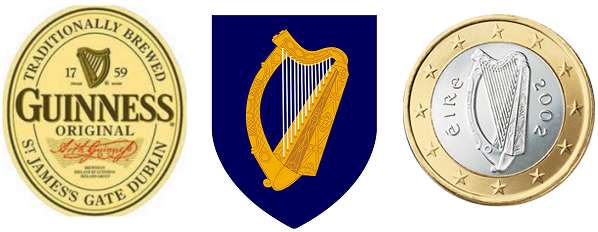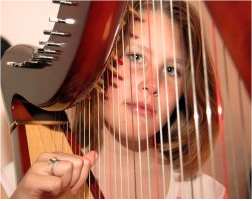|
The Feel-Good Guide to Sports, Travel, Shopping & Entertainment
|
| Main | Sports Events | Holidays & Observances | Pop Culture | Shopping | Travel |
|
Main The Irish Harp The
harp that once through Tara's halls the soul of music shed,
Legend tell us the first harp was owned by Dagda, a chief among the Tuatha De Danaan. At one time during a war with the Fomorians, the gods of cold and darkness, his harp was stolen but later recovered by Lugh and Ogma. When it was returned it had acquired two secret names and the ability to call forth summer and winter. From then on, when Dagda played, he could produce a melody so poignant, it would make his audience weep, he could play an air so jubilant it would make everyone smile, or bring forth a sound so tranquil, it would lull all who listened to sleep. So thus did the harp became the dispenser of Sorrow, Gladness and Rest. Harps are
played throughout much of the world. From ancient artworks, epic
tales and poetry, we learn of harps in Babylon and Mesopotamia.
We see them in the tomb of Pharaoh Ramses III , votive carvings
from Iraq and sculptures of ancient Greece. From Africa, which
has more than 100 harp traditions, the instrument traveled north
to Spain and soon spread throughout Europe.
Griffith of Wales employed harpists in his court at the end of the 11th century and the monk-historian Geraldus Cambrensis admired the great skill of the Irish harpers and remarked that some even considered the Scots to be better players. For Irish and Scottish harpers commonly visited each other’s countries to study, to learn and exchange tunes and their music was admired throughout Europe. Another twelfth century archivist, John of Salisbury, wrote that " ... had it not been for the Irish harp, there would have been no music at all on the Crusades." These harps
were quite different from the large pedal harps we see in modern
symphony orchestras. They were much smaller, originally held on
the harper's lap, leaning against the left shoulder, had no pedals,
and usually were carved in one piece from bog wood. The
Trinity College Harp and Queen
Mary's Harp are the oldest surviving Celtic harps and both
date from the 15th or 16th centuries and illustrate the similarity
between the Irish and Scottish harps. The harp isn't peculiar to Ireland but subsequently became its national emblem. (Nowadays you can even see it on the Guiness label) Harpers were highly trained professionals who performed for the nobility and enjoyed political power - so much so that during the 16th century, Queen Elizabeth I issued a proclamation to hang Irish harpists and destroy their instruments to prevent insurrection. Sadly, while this oldest emblem of Ireland is still with us today most of the ancient airs and melodies it once produced are long gone, but younger harpers are taking up the challenge to reawaken "the pride of former days." About the Author... Susanna Duffy is a Civil Celebrant, grief counsellor and mythologist. She creates ceremonies and Rites of Passage for individual and civic functions, and specialises in Croning and other celebrations for women.
|
||||||||
 To
tell the
To
tell the 
 A distinguishing characteristic
of these Gaelic harps was that they were wire-strung, rather than
gut strung. The word "harp" has its roots in the Anglo-Saxon,
Old German and Old Norse words which mean "to pluck." In Gaelic
they were known first as cruit and later as clarsach or cláirseach.
A distinguishing characteristic
of these Gaelic harps was that they were wire-strung, rather than
gut strung. The word "harp" has its roots in the Anglo-Saxon,
Old German and Old Norse words which mean "to pluck." In Gaelic
they were known first as cruit and later as clarsach or cláirseach.

